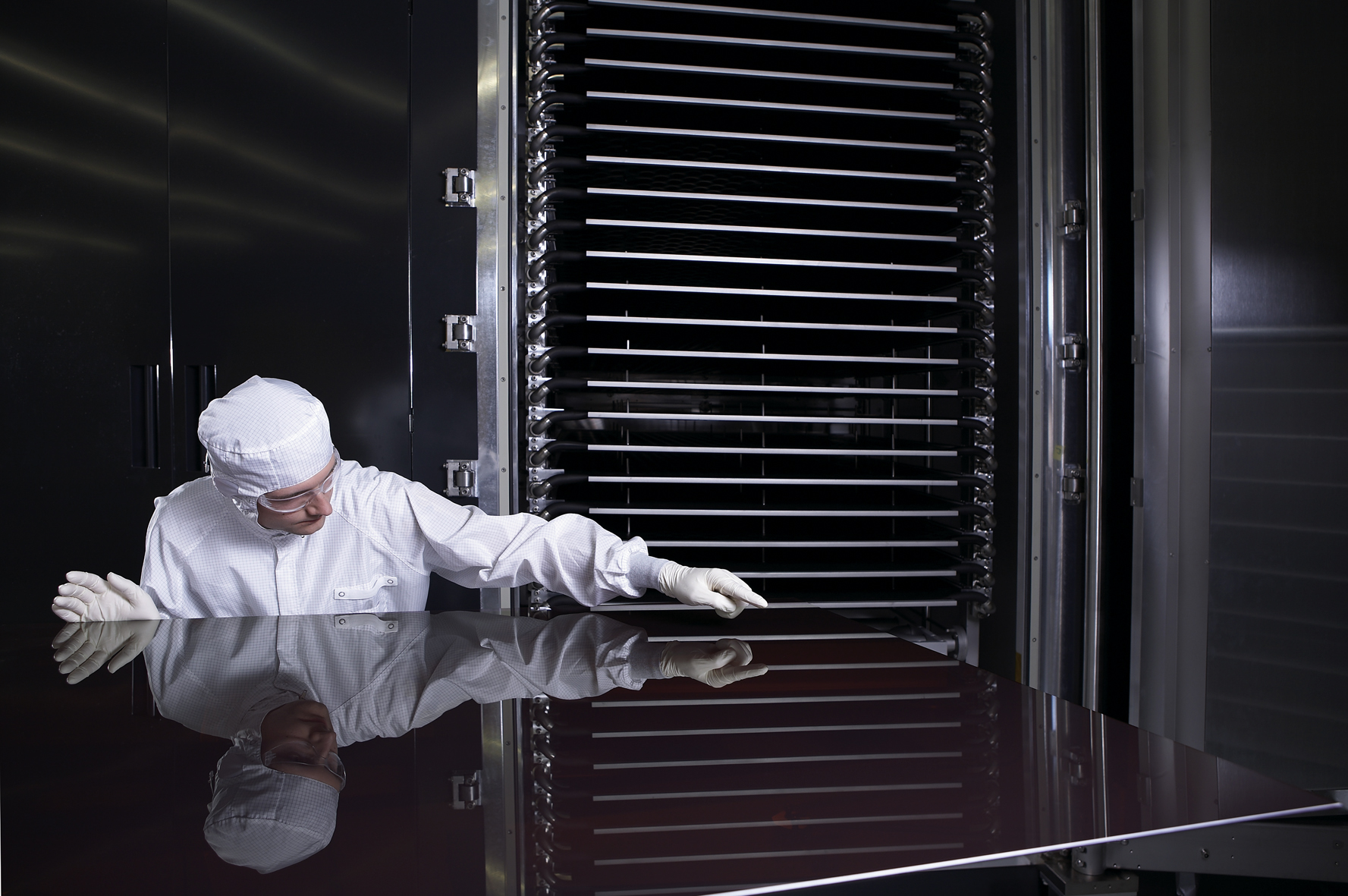
Features
Business intelligence
Contracting
Thin-film technology breakthrough
Thin film technology is particularly interesting to glass machinery manufacturers
October 16, 2009 By SASCHA RENTZING
Glass is the connecting element currently the focus of attention for the solar energy industry.

|
|
| A staff member of Berlin-based Inventux inspects the surface of a thin-film silicon module. (Photo courtesy of Inventux.)
|
Glass is the connecting element currently the focus of attention for the solar energy industry.
Glass equally connects the cell, module and primary product manufacturers, mechanical engineers and system integrators involved in solar cell production.
Thin film technology is particularly interesting to glass machinery manufacturers as glass is used as the base material and to cover solar cells. The production methods are very similar to those used when producing insulating glass, presenting a new opportunity for the machinery sector. The Centre for Research into Solar Energy and Hydrogen Research (ZSW) is closing the gap in the race to market the most efficient thin-film solar cell. Its copper-indium-gallium-diselenide-based CIS cells achieved efficiencies of up to 19.6 per cent in a pre-industrial production line. This means that the German based research workers are hot on the trail of the U.S.-based National Renewable Energy Laboratory, scoring efficiencies of up to 19.9 per cent under the same conditions.
Michael Powalla, head of the ZSW photovoltaics section, says the next hurdle is 20 per cent. This would take the CIS technology into the efficiency ranges of available crystalline photovoltaics equipment. Multicrystalline silicon cells have reached efficiency rates of 20.3 per cent under laboratory conditions.
But CIS technology is still lagging behind when it comes to practical applications. Industry-manufactured modules of this type of semi-conductor turn a maximum of 12 per cent of sunlight into electricity. Multicrystalline modules manage up to 18.5 per cent, while monocrystalline units score conversion rates of up to 20 per cent.
Production costs per watt of electricity generated is the same as silicon modules so CIS is still miles away from achieving its major objective, which is to generate electricity at prices undercutting all other competitors.
Other thin-film technologies cannot take up this challenge either. The experts say that thin-film silicon modules may score efficiency rates of over 15 per cent, and they may be manufactured for less. At present they merely manage to score efficiencies of around nine per cent and they are about three times as expensive to make. Yet CIS, thin-film silicon and related devices, are preparing for a major leap in development.
According to Arnulf Jaeger-Waldau, an energy specialist working for the European Commission, at present some 200 companies are making thin-film modules or are working on them. This leads the European PhotoVoltaics Industry Association (EPIA) to expect that manufacturing capacities for these technologies will double to over four gigawatts by 2010 – representing a market share of around 20 percent.
At the same time, new manufacturing technologies and advances in automation make for ever more efficient production. Mass production and technological progress bring down costs and raise market chances.
Newcomers in the thin-film sector do not have much time to present their products for series production. This is because their competitors from the crystalline sector are also spending great efforts on developing new technologies: efficiencies go up and costs are falling.
Experts also view so-called back contact cells as offering great potential. Bus bars and contacts are no longer to be found at the front but rather at the back side of solar cells, thus enlarging the solar-active surface of these modules.
Manufacturers that want to get into thin-film modules will face fierce battles to obtain market share. To begin with, their technology may face difficulties where large outputs are to be generated from a small surface area, because of fairly low efficiencies.
Because of their flexibility and low weight, thin-film modules may be more easily integrated into the building envelope when compared to electricity-generating windows or facades. They can improve the energy balance of a building while giving more creative freedom to architects and planners.
Numerous creative solutions for building-integrated photovoltaics have already been demonstrated at the Glasstec trade fair in 2008.
In theory, thin-film cells may seem like a potential growth market for glass manufacturers but they will first have to turn their ideas into capacities.
The introduction of thin-film technology at trade shows such as solarpeq and Glasstec 2010, will point the way to developments in the glass industry will go, because there is hardly any other sector depending to such a degree on the influence of innovations to revolutionize manufacturing technologies. •
Solarpeq is a new event for the solar sector. The Trade Fair for Solar Production Equipment is held concurrently with Glasstec, an international forum for companies selling or buying machinery for producing and processing silicon, wafers, solar cells and modules.
Print this page